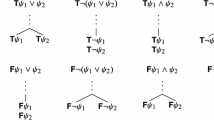Abstract
We consider question-answer dialogues between participants who may disagree with each other. The main problems are: (a) How different speech-acts affect the information in the dialogue; and (b) How to represent what was said in a dialogue, so that we can summarize it even when it involves disagreements (i.e., inconsistencies).
We use a fully-typed many-sorted language L with a possible-worlds semantics. L contains nominals representing ‘short answers’. The speech-acts are uniformly represented in a dialogue language DL by ‘focus structures’, consisting of a mood operator, a topic component and a focus component. Each stage of the dialogue is associated with a set of ‘information functions’ (g-functions), which are partial functions taking a topic component (representing a question raised) to a set of propositions determined by the corresponding focus component (to the set of answers given to it).
Asserting is answering a question and, hence, it causes a new g-function to be defined. Asking is an attempt to cause the hearer to define a new g-function satisfying certain conditions. A question asked requests a true and complete answer. A reaction answers a question if it satisfies some of the conditions of the question. Indirect questions are viewed as indirect answers.
A dialogue representation consists of: commitment sets, each representing the commitments expressed by one participant; sets of ‘questions under discussion’ associated with each stage of the dialogue, and the common ground, containing the g-functions and representing consistently what was said in the dialogue.
Concepts of informativeness are naturally defined within the theory. Whether an utterance is informative depends on which question it answers and how the question was answered previously. These concepts yield that uttering mathematical and logical truths is as informative as uttering a contingency.
Similar content being viewed by others
References
Aqvist, L. E.: 1965, A New Approach to the Logical Theory of Interrogatives, Part I, Filosofiska Foreningen, Almqvist & Wiksel, Uppsala.
Batens, D.: 1982, ‘Dynamic Dialectical Logics’, Mimeographed.
Belnap, N. D.: 1977, ‘A Useful Four-valued Logic’, J. M. Dunn and G. Epstein (eds.), Modern Uses of Multiple Valued Logic, Reidel, Dordrecht.
Belnap, N. D. and Steel, T. B.: 1976, The Logic of Questions and Answers, Yale University, New Haven and London.
Collingwood, R. G.: 1939, An Autobiography, Oxford University, Oxford.
Collingwood, R. G.: 1940, An Essay on Metaphysics, Oxford University, Oxford.
Dretske, F. I.: 1972, ‘Contrastive Statements’, Philosophical Review 81, 411–437.
Grice, P.: 1975, ‘Logic and Conversation’, P. Cole and J. L. Morgan (eds.), Syntax and Semantics, vol. 3, Academic Press, New York, pp. 41–58.
Grosz, B. J.: 1981, ‘Focusing and Description in Natural Language Dialogue’, A. K. Joshi, B. L. Webber and I. A. Saag (eds.), Elements of Discourse Understanding, Cambridge University Press, pp. 84–105.
Hamblin, C. L.: 1970, Fallacies, Methuen, London.
Hintikka, J.: 1976, The Semantics of Questions and Questions of Semantics, Acta Philosophica Fennica, Vol. 28, 4, Helsinki, Finland.
Kamp, H.: 1984, ‘Discourse Representation’, S. Peters (ed), Situations in Discourse, Technical Report of the Center for the Study of Language and Information, Stanford University California.
Karttunen, L.: 1978, ‘Syntax and Semantics of Questions’, in H. Hiż (ed.), Questions, D. Reidel, Dordrecht.
Manor, R.: 1975, ‘On Propositional Commitment and Presupposition’, American Philosophical Quarterly 12, 141–149.
Manor, R.: 1976, ‘An Analysis of a Speech’, Theoretical Linguistics 3, 125–143.
Manor, R.: 1982a, ‘Answers and other reactions’, Theoretical Linguistics 9, 69–94.
Manor, R.: 1982b, ‘Pragmatics and the logics of questions and assertions’, Philosophica 29, 45–95.
Manor, R.: 1983, ‘Representing Dialogues’, Working Papers of the Sonderforschungsbereich 99, No. 82, Konstanz.
Reinhart, T.: 1981, ‘Pragmatics and Linguistics: An Analysis of Sentence Topics’, Philosophica 28.
Rescher, N. and R. Manor: 1970, ‘On Inferences from Inconsistent Premisses’, Theory and Decision 1, 179–217.
Stalnaker, R. C.: 1978, ‘Assertion’, in P. Cole and J. L. Morgan (eds.), Syntax and Semantics, Vol. 9, Academic Press, New York, pp. 315–332.
Stechow, A. V.: 1980, ‘Notes on Topic and Focus of Interrogatives and Indicatives’, Working Papers of the Sonderforschungsbereich 99, No. 45, Konstanz.
Author information
Authors and Affiliations
Rights and permissions
About this article
Cite this article
Manor, R. Dialogue representation. Topoi 3, 63–73 (1984). https://doi.org/10.1007/BF00136121
Issue Date:
DOI: https://doi.org/10.1007/BF00136121




